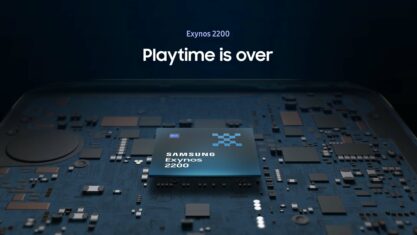Samsung announced its latest mobile processor, the Exynos 2200, sporting a new graphics processing unit (GPU) using AMD’s RDNA 2 architecture dubbed ‘Xclipse.’
Samsung has teased plans to include AMD graphics tech in its mobile chips for a while now, and in June 2021 announced that its upcoming Exynos chip would offer ray-tracing capabilities. The Exynos 2200 delivers on that promise with hardware-accelerated ray tracing in Xclipse.
Ray tracing, for those unfamiliar with the tech, attempts to simulate how light physically behaves. In video games, ray tracing can help produce more realistic-looking lighting effects, including light that can bounce off reflective surfaces. However, so far ray tracing has proven to be difficult for GPUs to handle and often brings a significant performance hit compared to other lighting solutions.
Still, it’s impressive to see the technology come to mobile chips. It’ll be interesting to see how well it works in practice. Moreover, Samsung shared this surprisingly weird video touting the capabilities of the Exynos 2200 GPU:
Aside from the benefits of AMD RDNA 2 and ray tracing in Xclipse, the Exynos 2200 chip sports other benefits. Samsung says the chip uses a 4nm extreme ultraviolet lithography (EUV) process and is one of the first in the mark to integrate Arm’s latest ARMv9 CPU cores. The ARMv9 cores offer a significant improvement over ARMv8 in both performance and security.
Specifically, the octa-core Exynos 2200 sports a tri-cluster structure with a single ARM Cortex-X2 core, three performance and efficiency balanced Cortex-A710 ‘big cores’ and four power-efficient Cortex-A510 ‘little cores.’
Exynos 2200 also support powerful on-device artificial intelligence (AI) thanks to an upgraded neural processing unit (NPU) and both sub-6 and mmWave 5G through an improved modem.
Finally, Samsung touted the chip’s image signal processor (ISP), which has a redesigned architecture that supports resolutions of up to 200 megapixels. When recording video at 30fps, the ISP supports up to 108 megapixels in single camera mode and 64+36 megapixels in dual camera mode. The ISP can connect up to seven individual image sensors and drive four sensors simultaneously for multi-camera set-ups. The ISP also supports up to 4K HDR or 8K recording.
While the Exynos 2200 certainly sounds impressive, Canadians might not get to try it out. Samsung typically launches its flagship phones in Canada with Qualcomm Snapdragon chips instead of its own Exynos (usually, Exynos chips power Samsung devices outside of North America). Of course, we won’t know for certain until devices rocking the Exynos 2200 release — for now, though, it’s probably safe to assume we won’t get those devices in Canada.
Those interested in learning more about the Exynos 2200 can check out all the details on Samsung’s website.
Image credit: Samsung
Source link




